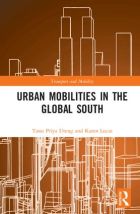Urban Mobilities in the Global South

Urban Mobilities in the Global South is an edited volume that presents case studies and empirical examples of transport planning and practice in the global South. The editors’ objectives are to “create a knowledge-based starting point for more inclusive planning for sustainable mobilities in cities of the Global South, and for post-colonial cities worldwide” and to “further bolster the mobilities concept within this context” (pages 219 and 1). They also seek to highlight the fundamental differences of accessibility and mobility between the global North and developing post-colonial cities, and argue the crucial importance of “locally produced” knowledge and solutions (page 215).
This book’s 10 chapters, written by a number of development researchers and practitioners, are sandwiched between an introduction and epilogue by the editors, Uteng and Lucas. The introduction describes the trajectories of urban mobilities in the global South and describes why the mobilities concept is so useful for exploring the asymmetries of power and denied opportunities within Southern cities (page 3). It also emphasizes our increasingly urban world and therefore the need to engage with it through concepts like the “right to the city” invoked by the New Urban Agenda (page 10).
The epilogue concludes the book by reflecting on what lessons its chapters provide for creating new knowledge for city planning in the global South. It suggests that next steps include combining evidence-based and experience-based knowledge for planning of more sustainable mobilities (page 219).
Chapter 1 looks at cycling for social justice in democratizing contexts, focusing on social sustainability in Delhi and Santiago. It concludes that how human agency and land use and transport planning interact plays a significant role in the success of cycle inclusion and intermodality (page 36).
Chapter 2 explores negotiated access on the streets of Hanoi and how mobility acts as a tool of resistance for street vendors against large-scale master plans and urban governance policies.
The intersection of physical and virtual mobilities in urban South Africa is explored in Chapter 3 by drawing upon field research among young people in two poor, high-density neighbourhoods within smaller urban centres.
Chapter 4 describes research into the role of motorcycle taxis to provide mobility and income for the poorest inhabitants of Kampala, Uganda.
Looking at Maputo and Nairobi, Chapter 5 illustrates how comparative analysis of master plans reveals the gap in official planning for paratransit systems, and also how efforts to produce collaborative paratransit mapping can lead to more inclusive planning.
Chapter 6 looks to the city of Bandung, Indonesia, to understand how rapid urbanization has affected time use patterns and travel of different socio-demographic groups.
Chapter 7 uses case study research on the public passenger transport system in Dar es Salaam to evaluate whether the distinction between “formal” and “informal” transport services is appropriate. Concluding that it is not, the chapter explores the potential use and value of institutional or urban bricolage.
Through an analysis of the regulatory role of (im)mobility in South Africa both during apartheid and post-apartheid, Chapter 8 illustrates how important it is to understand this for directing resources effectively. The aims are to maximize easy and just mobility and to create a more just political economy (page 155).
Drawing upon a case study of low-income and vulnerable groups in Abuja, Nigeria, Chapter 9 explores how transport-related vulnerability and disadvantages are addressed by local transport. It highlights the important role transport plays in wellbeing, and further emphasizes the influence of transport policy on the lives of the poor.
To end, Chapter 10 discusses undertheorized mobilities. Specifically, it develops a conceptual framework made up of agency, encounters and action in order to challenge, broaden and reshape how knowledge is created in the global South about (im)mobilities.
Book note prepared by Hannah Keren Lee
Search the Book notes database
Our Book notes database contains details and summaries of all the publications included in Book notes since 1993 - with details on how to obtain/download.
Use the search form above, or visit the Book notes landing page for more options and latest content.
For a searchable database for papers in Environment and Urbanization, go to http://eau.sagepub.com/

